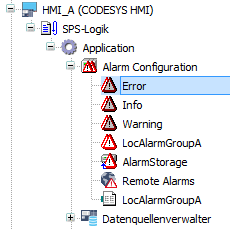Object: Remote Alarms
Remote alarm classes and groups are managed in this object.
For alarm management, this means that observation and alarm triggering is done on the remote PLCs. The local alarm management communicates with the remote PLCs via a data source management (over a proxy server) and therefore recognizes the remote alarms. Then a visualization that is connected to the local alarm management can display remote alarms. The user can operate and acknowledge the alarms.
Update | Opens the Update Alarm Classes and Groups dialog described below |
Alarm Groups / Classes | Hierarchical representation of the alarm data of remote devices with their applications, alarm groups, and classes. The remote devices are connected via the data source management. |
Map to Local | . List with an blank entry and the alarm classes of the local alarm configuration
|
Dialog: Update Alarm Classes and Groups
This dialog shows the current alarm definitions of the devices connected via the data source management. The relevant data of the Alarm Class and Alarm Group objects are retrieved.
Alarm Groups / Classes | Hierarchical representation of the alarm data of remote devices with their applications, alarm groups, and classes. The remote devices are connected via the data source management.
|
OK | Confirms the settings, updates the alarm data, and closes the dialog. |

